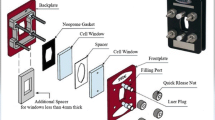Abstract
Examples of the frequency range of blood glucose dynamics of normal subjects and subjects with diabetes are reported here, based on data from the literature. The frequency band edge was determined from suitable, frequently sampled blood glucose recordings using two methods: frequency domain estimation and signal reconstruction. The respective maximum acceptable sampling intervals, or Nyquist sampling periods (NSP), required to accurately represent blood glucose dynamics were calculated. Preliminary results based on the limited data available in the literature indicate that although blood glucose NSP values are higher in most diabetic subjects, values in some diabetic subjects are indistinguishable from those of normal subjects. High fidelity monitoring sufficient to follow the intrinsic blood glucose dynamics of all diabetic subjects requires a NSP of ~ 10 min, corresponding to a continuous frequency band edge of ~ 1 × 10−3 Hz. This analysis provides key information for the design of clinical studies that include blood glucose dynamics and for the design of new glucose monitoring systems. © 2003 Biomedical Engineering Society.
Similar content being viewed by others
REFERENCES
Bremer, T., and D. A. Gough. Is blood glucose predictable from previous values? A solicitation for data. Diabetes48:445451, 1999.
Bremer, T. M., S. V. Edelman, and D. A. Gough. Benchmark data from the literature for evaluation of new glucose sensing technologies. Diabetes Tech., Therapeu.3:409418, 2001.
Gabbay, K. H., K. Hasty, J. L. Breslow, R. C. Ellison, H. F. Bunn, and P. M. Gallop. Glycosylated hemoglobins and longterm blood glucose control in diabetes mellitus. J. Clin. Endocrin., Metab.44:859864, 1977.
glucosecontrol.ucsd.edu
Molnar, G. D., E. Ackerman, J. W. Rosevear, L. C. Gatewood, and K. E. Moxness. Continuous blood glucose analysis in ambulatory fed subjects. I. General methodology. Mayo Clin. Proc.43:833851, 1968.
Ohno, M., K. Ito, S. Saito, S. Kageyama, Y. Ikeda, T. Tanese, and M. Abe. Clinical usefulness of artificial endocrine pancreas “Biostator” in management of unstable diabetics. Tohoku J. Exper. Med.141:723732, 1983.
Oppenheim, A. V., and R. W. Schafer. DiscreteTime Signal Processing. Englewood Cliffs, NJ: Prentice Hall, 1989.
Pfeiffer, E. F., C. Meyerhoff, F. Bischof, F. S. Keck, and W. Kerner. On line continuous monitoring of subcutaneous tissue glucose is feasible by combining portable glucosensor with microdialysis. Horm. Metab. Res.25:121124, 1993.
Reichard, P., B.Y. Nilsson, and U. Rosenqvist. The effect of longterm intensified insulin treatment on the development of microvascular complications of diabetes mellitus. N. Eng. J. Med.329:304309, 1993.
Santiago, J. V., W. L. Clarke, and F. Arias. Studies with a pancreatic beta cell simulator in the third trimester of pregnancies complicated by diabetes. Am. J. Obstet. Gynecol.132:455463, 1978.
Service, F. J., G. D. Molnar, J. W. Rosevear, E. Ackerman, W. F. Taylor, G. M. Cremer, and K. E. Moxness. Continuous blood glucose analysis in ambulatory fed subjects. II. Effects of anticoagulation with heparin. Mayo Clin. Proc.44:466477, 1969.
Service, F. J., G. D. Molnar, J. W. Rosevear, E. Ackerman, L. C. Gatewood, and W. F. Taylor. Mean amplitude of glycemic excursions, a measure of diabetic instability. Diabetes19:644655, 1970.
Service, F. J., G. D. Molnar, and W. F. Taylor. Urine glucose analyses during continuous monitoring. J. Am. Med. Assoc.222:294298, 1972.
Slama, G., J. C. Klein, M. C. Tardieu, and G. Tchobroutsky. The normalization of blood sugar using a nonminiaturized artificial pancreas. Application for 24 h in seven insulindependent diabetics. Nouv. Presse Med.6:23092313, 1977.
The Diabetes Control and Complications Trial Research Group. The effect of intensive treatment of diabetes on the development and progression of longterm complications in insulindependent diabetes mellitus. N. Engl. J. Med.329:977986, 1993.
United Kingdom Prospective Diabetes Study Group. Intensive bloodglucose control with sulfonylureas or insulin compared with conventional treatment and the risk of complications in patients with type 2 diabetes. Lancet352:837853, 1998.
Zimmet, P., K. G. M. Alberti, and J. Shaw. Global and societal implications of the diabetes epidemic. Nature (London)414:782787, 2001.
Author information
Authors and Affiliations
Rights and permissions
About this article
Cite this article
Gough, D.A., Kreutz-Delgado, K. & Bremer, T.M. Frequency Characterization of Blood Glucose Dynamics. Annals of Biomedical Engineering 31, 91–97 (2003). https://doi.org/10.1114/1.1535411
Issue Date:
DOI: https://doi.org/10.1114/1.1535411




